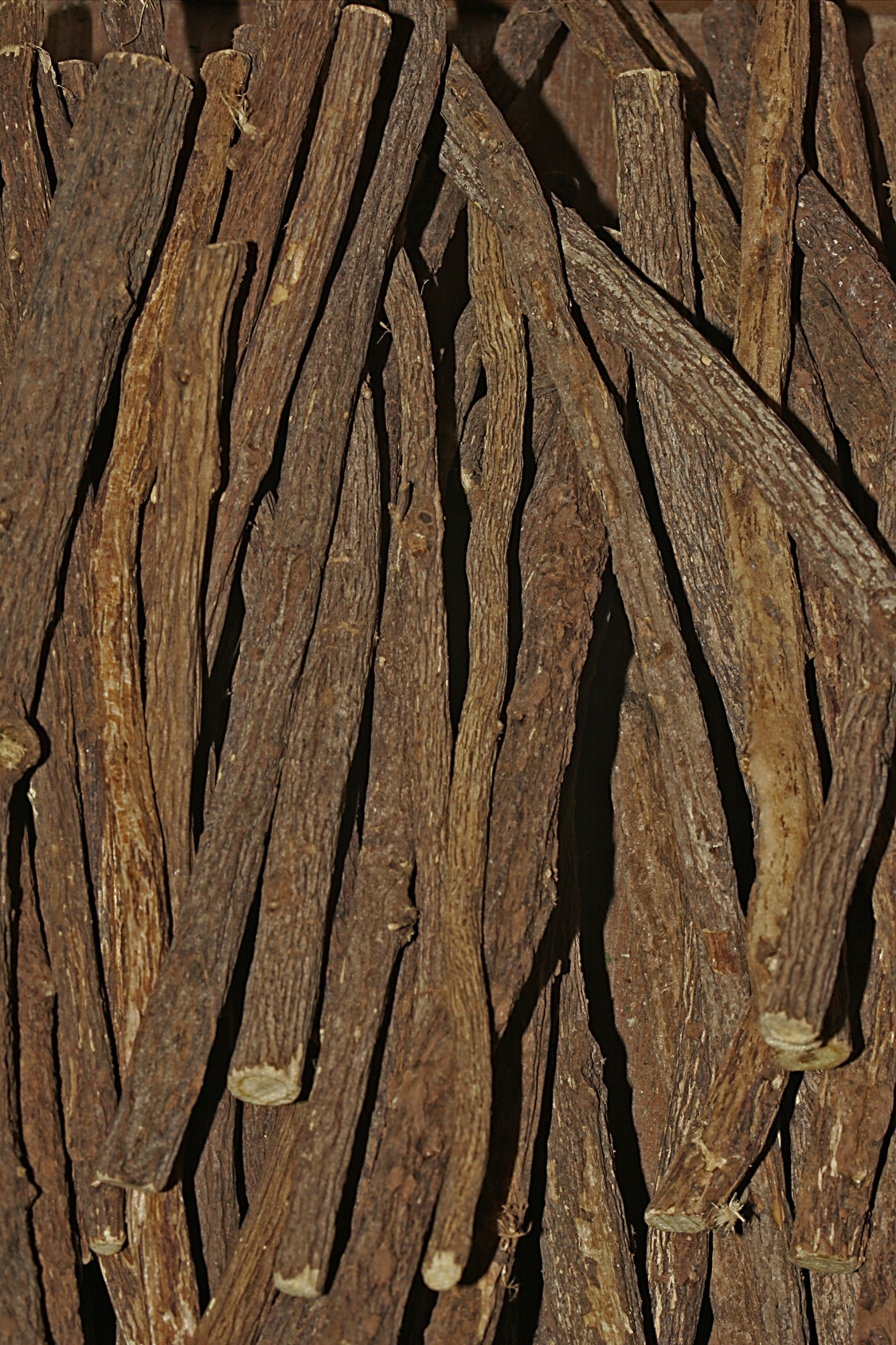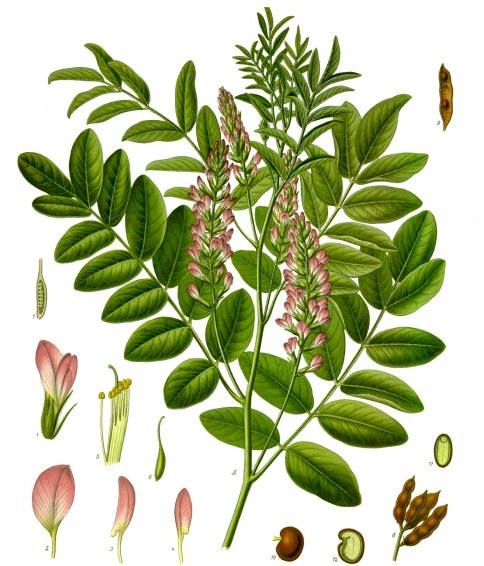
Glycyrrhiza glabra (L)
Synonyms: Liquirita officinalis (L.), reglisse, lacrisse, sweet licorice, licorice root, sweet wood.
Order: Leguminosae
Description: Glycyrrhiza is a tall, erect perennial plant with light, gracefully-spreading pinnate foliage and dark green lanceolate leaflets that hang down at night. Long-stemmed spikes of numerous bluish-purple to white papillonaceous flowers grow from the leaf axils and appear from June to August, followed by small leguminous smooth-skinned seed pods. The roots are brown, long and cylindrical. Glycyrrhiza is native to south-eastern Europe and south-west Asia to Iran, growing in open fields close to running water. It was commercially cultivated until recently in northern England.

Parts used: dried roots and stolons
Collection: The roots are unearthed in the autumn of the fourth season
Constituents: glycosides called glycyrrhizin (about 7%) and glycyrrhizinic acid, triterpenoid glycosides (saponins), flavonoids (including liquiritigetol) and isoflavonoids, bitter principle (glycyrmarin), volatile oil, chalcones, coumarins, amino acids, amines (choline, betaine, asparagine), oestrogenic substances (including beta-sitosterol), glucose and sucrose (5-15% sugars), starch, tannins (trace), gums, wax.
Actions: expectorant, antitussive, demulcent, spasmolytic, anti-inflammatory, adrenocorticotrophic (stimulates the cortex of the adrenal gland), anti-allergic, mild laxative
Indications: bronchial catarrh, bronchitis, chronic gastritis, peptic ulcer, colic, primary adrenocortical insufficiency. Specifically indicated in Addison's disease.
Therapeutics and Pharmacology:
Glycyrrhiza has a marked effect upon the endocrine system. Its glycosides are
structurally similar to the natural steroids
of the body, and are responsible for the beneficial action that this herb has in the
treatment of adrenal gland problems such as Addison's disease. Glycyrrhizin is fifty times stronger than sucrose, which encourages the
production of hormones such as hydrocortisone. This helps to explain its
anti-inflammatory action and also its role in stimulating the adrenal cortex
after steroid therapy. It has an ACTH-like action on the adrenal cortex,
increasing the production of gluco- and mineralocorticoids. It is used in allopathic medicine as a treatment for
peptic ulceration, a similar use to its herbal use in gastritis and ulcers. It produces a
highly viscous mucus over the stomach wall and reduces gastric acid secretion
and eases spasms of the large intestine. It increases the secretion of bilirubin in the bile and
lowers blood cholesterol levels.
Glycyrrhiza is widely used in bronchial problems such as catarrh, bronchitis and coughs. It reduces irritation of the throat and yet has an expectorant action. It produces its demulcent and expectorant effects by stimulation of tracheal mucous secretion. It is a potent healing agent for tuberculosis, where its effects have been compared to hydrocortisone. Glycyrrhiza is also effective in helping to reduce fevers (glycyrretinic acid has an effect like aspirin), and it may have an antibacterial action as well. It can neutralise many toxins such as those of diphtheria and tetanus. Its anti-inflammatory action accounts for its use in the treatment of chronic inflammations such as arthritic and rheumatic diseases, chronic skin conditions, and autoimmune diseases in general. It may also be used as an eyebath in conjunctivitis and other inflammatory conditions of the eye surface.
Glycyrrhiza has an antipyretic effect comparable to sodium salicylate. Asparagine is a potent diuretic, leading to speculation that its presence may reduce the chance of the whole plant increasing blood pressure compared with isolated glycyrretinic acid.
The solidified extract, sold in sticks, forms the basis of many proprietary laxatives, stimulating bile flow, with a gentle action in constipation. Glycyrrhiza can be used as a non-sucrose sweetener, and can be taken safely by diabetics.
Combinations: Glycyrrhiza may be combined with Linum, Lobelia and Capsicum, or with Tussilago and Marrubium in bronchitis; with Symphytum, Chamaemelum, Filipendula and Althaea root in peptic ulcer; and with Taraxacum herba in Addison's disease.
Caution: Long-term usage at high doses may cause sodium retention, low potassium levels and hypertension (although asparagine does act to counter this tendency). Vertigo and headaches may also develop. Large doses over a prolonged period may also result in hypokalaemia. Potassium intake should be increased and a low salt diet should be recommended to minimise water retention. The DASH Diet and the Medifast Diet are only two of the many diets that may meet your goals by providing you with low sodium meals. Glycyrrhiza should not be taken by people on digoxin-based drugs. It should also be avoided during pregnancy and in cirrhosis of the liver.
Preparation and Dosage: (thrice daily)
Regulatory status GSL
Powdered root: 1-4g or by decoction
Liquid Extract: (BP 1973) 2-5ml
Additional Comments: Liquorice was one of the most widely known medicines in ancient history, and records of its use include Assyrian tablets of around 2000 BC and Chinese herbals of the same period. Theophrastos of Lesbos, writing in the fourth century BC wrote that 'it has the property of quenching thirst if one holds it in the mouth'. Dioscorides gave the plant its botanical name (Greek glukos = sweet, riza = root). Its 13th century English name was Lycorys, a corruption of glycyrrhiza. The plant originated in the Mediterranean and the Middle East, but has been cultivated in Europe since at least the 16th century. In China, G. uralensis or gan cao, known as the 'great detoxifier', is thought to drive poisons from the system. It is also an important tonic, often called 'the grandfather of herbs'. Gan cao is used as an energy tonic, particularly for the spleen and stomach, and the root is added to many Chinese formulae to balance other herbs. It is also used for asthmatic coughs, as an antispasmodic and ulcer remedy, and to cool 'hot' conditions. The dried root is given to Chinese children to promote muscle growth. Liquorice is often used as a method for disguising the taste of medicines and as a flavouring in confectionery.
Bibliography
BHMA 1983 British Herbal Pharmacopoeia, BHMA, Bournemouth.
Bradley, P.R. (ed.) 1992 British Herbal Compendium, Volume 1, BHMA, Bournemouth.
Grieve, M. 1931 A Modern Herbal, (ed. C.F. Leyel 1985), London.
Hoffmann, D. 1990 The New Holistic Herbal, Second Edition, Element, Shaftesbury.
Lust, J. 1990 The Herb Book, Bantam, London.
Mabey, R. (ed.) 1991 The Complete New Herbal, Penguin, London.
Mills, S.Y. 1993 The Essential Book of Herbal Medicine, Penguin, London (First published in 1991 as Out of the Earth, Arkana)
Mills, S.Y. 1993 The A-Z of Modern Herbalism, Diamond Books, London.
Ody, P. 1993 The Herb Society's Complete Medicinal Herbal, Dorling Kindersley, London.
Polunin, M. and Robbins, C. 1992 The Natural Pharmacy, Dorling Kindersley, London.
Weiss, R.F. 1991 Herbal Medicine, Beaconsfield Arcanum, Beaconsfield.
Wren, R.C. 1988 Potter's New Cyclopaedia of Botanical Drugs and Preparations, C.W.Daniel, Saffron Walden.










